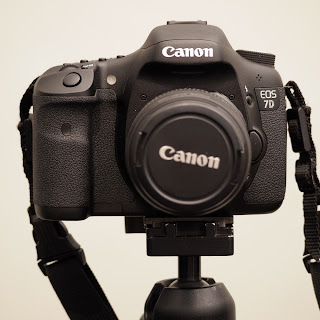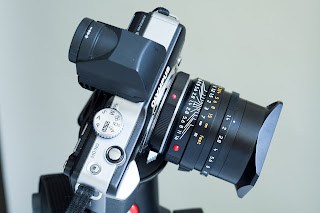One of the wealthiest men in my circle of friends is so thrifty that he only allows himself to go out and buy coffee at a coffee shop one day a week. A bunch of us meet to socialize and the lure of the social network outweighs his aversion to spending any money whatsoever. When he joins us he gets a medium sized coffee. He has an affinity card (free for the sign up) at the coffee house and it buys him a refill for free. When we're all getting ready to leave he gets his refill. This is not to drink on the way home. He explained it to me once. He puts the cup of coffee in the refrigerator at his house and then, the next morning he microwaves his free refill and enjoys his "free" cup of coffee.
If he were a photographer he would buy one camera and one camera only. That camera would be so carefully researched it would make Phd. candidates flinch. He would use it till the leatherette peeled off, the screen darkened, and the buttons were no longer usable. And, yes, he would maximize his initial investment until it was no longer possible to use the camera.
And then I have friends who have modest jobs but they spend their money with pleasure. They take vacations and splurge on fun stuff. They have hobbies and they buy books instead of ordering everything for free at the library. They'll buy another cup of (fresh) coffee the next day. They enjoy the things that spending money can buy them.
If they were photographers they'd change gear when they saw real advantages from new product introductions. Things that would make their jobs easier or, the files better. They wouldn't be focused on the gear, especially, but they would be cognizant of how innovation could bring them pleasure.
Finally I have a group of friends who have to have the best of everything. If they vacation they do it in St. Moritz instead of Durango. They drive just the right car, own just the right automatic watch and eat in the restaurants of the minute.
If they were photographers they'd be lining up to pre-order the best of everything. The newest Leica M10, the Fuji X1 Pro type 2 and whatever cool Canon or Nikon body was "of the moment." And just as they have a Range Rover to drive to workout and an M6 to drive to the office they would have the "walkabout" camera system (Nex or M4:3) as well as the full bore, big dog system. If they were really into photography they'd also have the cool medium format system of the day as well.
But these are not photographer specific types, these are people types and they exist on some inexact curve from thriftiest to most indulgent. The profession of photography is made up of all kinds of people. There is no one successful type that dominates our industry. There is no single set of buying habits that signals the highest probability of success.
One professional photographer I know here in town is so cheap he's probably still using the Nikon D1x he bought when he first started to dip his toes into digital photography. He does okay in business. There's another professional photographer who always has the latest of everything and the best. He's into medium format for his work, and the latest Canon, with all the lenses relevant to his business, and he dabbles in smaller camera systems as well. Hell, he's even into film Leicas and Hasselblads (it's not me, honest) but even though he outspends the first photographer by a wide, wide margin when it comes to gear he is also at the top of his game and is the busiest and highest paid photographer in our affluent market. As a percentage of income his gear acquisitions are not out of line with anyone else's. He just has more to spend. It's like the tax argument with Mitt Romney: He's only paying 13% but he's paying more in sheer volume than the other 99%.
Lately, when I read a forum response about my own "reckless spending" and fickle buying nature, when it comes to equipment, some self proclaimed "old sage" will chime in and mention that "the real professional photographers would never rashly buy equipment." As if to dismiss my professional relevance and tenure with his specious pronouncement. He always goes on to say, "They buy the best stuff out there and use it for a long, long time." This tells me that the poster has no sample group of photographers large enough to make any kind of statistically relevant observation of fact, and also that he may live in a severely depressed market where every family and business must make due with what's at hand instead of upgrading.
There is no statistically sound basis for understanding the spending models of different working photographers. There are some with huge trust funds who can buy whatever they want. Some are optimistic about their chances of success and so are willing to take risks to buy the ever evolving tools they see as necessary. Some are aging out of the profession and are reticent to buy stuff that won't give them some sort of quick and guaranteed return. Some feel trapped in the profession and are looking for a way out. To them the easy money is gone and it doesn't make sense to throw good money after bad.
Gear has gotten cheap for some photographers. You can buy so many really great cameras for under $2,000 dollars. Lenses hold their relative value which means changing camera systems isn't so onerous. Former president Reagan re-wrote the tax laws so professionals can write off, in the year of purchase, large amounts of equipment (ACRS). Some states have sales tax breaks for gear that you use in the creation of images for resale. The old, film age accounting rules no longer apply. The adherence to the old rules might actually be a hinderance for creative workers who use tools to their maximum effect and then evolve into the next tool. There is an advantage to being the first adopter of a trend or style... Who could have guessed that video in still cameras would become so good so soon? If you shoot a lot of video upgrading to a camera system with EVF's might make all the economic sense in the world. If you got a travel assignment with no budgets for assistants you might consider dragging around a huge roller full of big, heavy Nikon professional stuff but, if the subject matter allows it, you might also find it a smart investment (even for one extended job) to buy a much smaller and lighter micro four thirds system (Olympus OMD? Sony Nex?) and save your shoulders, back and luggage overage charges. For most applications the files may be just right.
The logic that a photographer buys and holds is a logic based on a time when most equipment was carried around by assistants, used with lots of lights and didn't change much from year to year. That logic is upside down now. Absolutely upside down. We're almost at the point where it makes more sense to buy and use your gear for the big job at hand, sell it and then choose different gear for the next, different style job. Matching your gear to the project. Or to rent specialty gear as needed and keep personal systems small and cheap enough so that you can turn direction in heartbeat.
When someone tells you, "That's the way professional photographers do it." Take their statement with a big grain of salt because every professional is different and follows their own patterns of acquisition for pleasure and for business. I can pretty much tell you this, the photographer who rarely changes equipment has either lost their pleasure for the business or is so involved in what they shoot that any upgrade is just meaningless. In the first camp are the gruff old cusses who wear the khaki vests and talk about "how we used to do it in the old days." The second camp is filled (sparsely) with artists who found their tools and can't imagine using anything else. Then there's this giant Bell Curve in the middle. And for the reading impaired........"That's just my personal opinion."
I might tell you (out of generational spite) that no professional would ever use the LCD screen of a camera to compose and shoot with. That an OVF or EVF was mandatory "pro gear." But I would be wrong and at a disadvantage because of my reticence to use a tool in the way that thousands of younger photographers (and their clients) are comfortable with every day. When reading the forums be sure to put your bullshit detector on high. Not everything you read on the web came straight from the keyboard of an infallible genius.....
Added today (August 20th): Think that pro gear is what you really need to do great work?
Read what Michael Reichman found out: http://www.luminous-landscape.com/reviews/kidding.shtml
















































